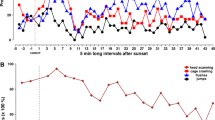Summary
To test the orientation model that the stars derive their directional significance from the magnetic field, the orientation of European Robins (Erithacus rubecula) to an arbitrary pattern of 16 “stars” (Fig. 1) was examined.
Control tests in a magnetic field too weak for orientation, where the birds showed random behavior (Fig. 2), demonstrated that the artificial star pattern by itself did not contain information of the migratory direction. The main experimental series consisted of sets of two tests performed on consecutive nights. In the first tests (N1), the birds were presented the artificial stars together with a magnetic field of adequate intensity and they oriented according to that magnetic field (Fig. 3a). In the second tests (N2), the “stars” remained unchanged (the cage was turned) and the magnetic field was of the same low intensity as in the control series; here the birds continued to show a directional preference that did not differ significantly from the mean of the nights before (Fig. 3 b).
These findings lead to the conclusion that by applying a suitable magnetic field a directional meaning had been given to the 16 “stars”, which allowed the birds to select the same directions as the night before. For this “star orientation” the natural sky could be replaced by a simple pattern of 16 artificial stars, indicating that number, position and configuration of the stars by themselves is meaningless until directional information from the magnetic field has been transferred to them. Thus the findings presented here support the orientation model that the directional significance of the star compass is dependent on the magnetic compass.
Similar content being viewed by others
References
Batschelet, E.: Recent statistical methods for orientation data. In: Animal orientation and navigation, NASA SP-262 (S.R. Galler et al., eds), pp. 61–93. Washington D.C.: U.S. Gov. Print. Off. 1972
Bellrose, F.C.: Possible steps in the evolutionary development of bird navigation. In: Animal orientation and navigation, NASA SP-626 (S.R. Galler et al., eds.), pp. 223–258. Washington D.C.: U.S. Gov. Print. Off. 1972
Conover, W.J.: Practical non-parametric statistics. New York-London-Sidney-Toronto: John Wiley & Sons, Inc. 1971
Howland, H.C.: Orientation of European Robins to Kramer cages. Z. Tierpsychol.33, 295–312 (1973)
Emlen, S.T.: Migratory orientation in the Indigo Bunting,Passerina cyanea. Part I: The evidence for use of celestial cues. Auk84, 309–342 (1967)
Emlen, S.T.: Celestial rotation: its importance in the development of migratory orientation. Science170, 1198–1201 (1970)
Emlen, S.T.: The ontogenetic development of orientation capabilities. In: Animal orientation and navigation, NASA SP-262 (S.R. Galler et al, eds.), pp. 191–210. Washington D.C.: U.S. Gov. Print. Off. 1972
Emlen, S.T.: Migration: orientation and navigation. In: Avian biology, Vol. 5 (D.S. Farner, J.R. King, eds.). London, New York: Academic Press 1975
Hamilton III., W.J.: Bobolink migratory pathways and their experimental analysis under night skies. Auk79, 208–233 (1962)
Merkel, F.W., Wiltschko, W.: Magnetismus und Richtungsfinden zugunruhiger Rotkehlchen (Erithacus rubecula). Vogelwarte23, 71–77 (1965)
Sauer, F.: Die Sternenorientierung nächtlich ziehender Grasmücken (Sylvia atricapilla, borin undcurruca). Z. Tierpsychol.14, 29–70 (1957)
Wallraff, H.G.: Über das Orientierungsvermögen von Vögeln unter natürlichen und künstlichen Sternmustern. Dressurversuche mit Stockenten. Zool. Anz., Suppl.32, 348–357 (1969)
Wallraff, H.G.: Nicht visuelle Orientierung zugunruhiger Rotkehlchen (Erithacus rubecula). Z. Tierpsychol.30, 374–382 (1972a)
Wallraff, H.G.: An approach toward an analysis of the pattern recognition involved in the stellar orientation of birds. In: Animal orientation and navigation, NASA SP-262 (S.R. Galler et al., eds.), pp. 211–222. Washington D.C.: U.S. Gov. Print. Off. 1972b
Wiltschko, W.: Über den Einfluß statischer Magnetfelder auf die Zugorientierung der Rotkehlchen (Erithacus rubecula). Z. Tierpsychol.25, 537–558 (1968)
Wiltschko, W.: The influence of magnetic total intensity and inclination on directions chosen by migrating European robins. In: Animal orientation and navigation, NASA SP-262 (S.R. Galler et al., eds.), pp. 569–578. Washington D.C.: U.S. Gov. Print. Off. 1972
Wiltschko, W.: Kompaßsysteme in der Orientierung von Zugvögeln. Inf. Org. (Akad. Wiss. u. Lit., Mainz)2, 93–140 (1973)
Wiltschko, W., Wiltschko, R.: Magnetic compass of European Robins. Science176, 62–64 (1972)
Wiltschko, W., Wiltschko, R.: The interaction of stars and magnetic field in the orientation system of night migrating birds. I. Autumn experiments with European Warblers (Gen.Sylvia). Z. Tierpsychol.37, 337–355 (1975a)
Wiltschko, W., Wiltschko, J.R.: The interaction of stars and magnetic field in the orientation system of night migrating birds. II. Spring experiments with European Robins (Erithacus rubecula). Z. Tierpsychol.39, 265–282 (1975b)
Author information
Authors and Affiliations
Additional information
This study was supported by the Deutsche Forschungsgemeinschaft; the computer work was carried out by the Hochschulrechenzentrum of the Universität Frankfurt. We would like to express our thanks to Miss D. Richter, Mrs. H. Theiss-Jahnke and H. Golle for their valuable help in capturing the test birds and conducting the experiments, to W.T. Keeton and F.W. Merkel for critically reading an early draft of the manuscript and especially to S.T. Emlen for many stimulating discussions.
Rights and permissions
About this article
Cite this article
Wiltschko, W., Wiltschko, R. Interrelation of magnetic compass and star orientation in night-migrating birds. J. Comp. Physiol. 109, 91–99 (1976). https://doi.org/10.1007/BF00663437
Received:
Issue Date:
DOI: https://doi.org/10.1007/BF00663437




